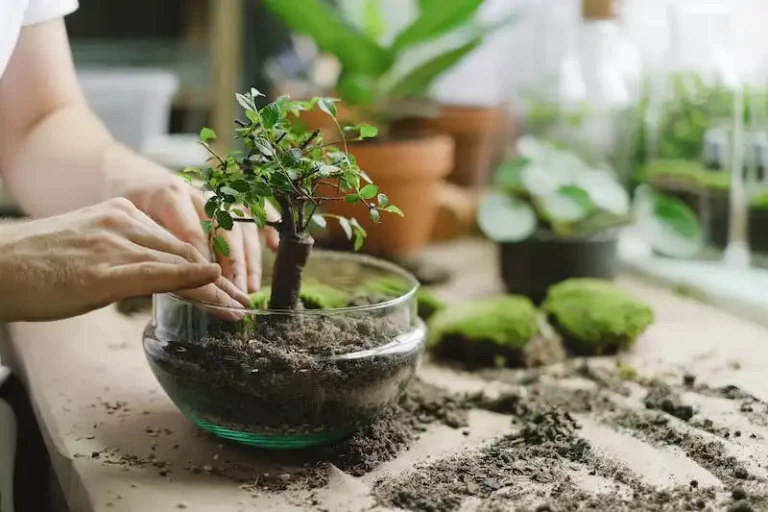Ferns are a common choice for indoor greenery due to their lush and vibrant foliage. However, taking care of ferns requires some specific knowledge and attention to ensure they thrive in your home. The key here is to be mindful of their watering needs. Ferns should be watered regularly, but you shouldn’t let the soil become waterlogged. If the top inch of the soil feels dry, then it’s time to water your fern. Remember, it’s better to underwater than overwater these plants.
When it comes to watering, it’s also important to think about the medium in which your fern is planted. Most ferns don’t like to sit in standing water, so make sure to empty any excess water from the saucer or dish after watering. If you’re unsure about the moisture level, you can lightly press the surface of the soil and only water if it feels dry.
In addition to watering, fertilizing is another important aspect of fern care. Ferns don’t need a lot of nutrients, so it’s best to use a diluted fertilizer once a month during the growing season. This will provide the necessary nutrients without overfeeding the plants. Be careful not to fertilize too often or use too much fertilizer, as this can lead to burned roots and other issues.
When it comes to the location of your fern, it’s important to find a spot that suits its light requirements. Most ferns prefer bright, indirect light, so placing them near a window or in a well-lit room is ideal. However, they should be protected from direct sunlight, as this can scorch their leaves. If you notice your fern is not getting enough light, you can always move it to a brighter location.
Another important factor to consider is the humidity levels in your home. Ferns thrive in environments with higher humidity, so if your home is dry, you may need to increase the moisture levels around your plants. This can be done by misting the leaves with water, placing a humidifier nearby, or even grouping your fern with other plants to create a humid microclimate.
In conclusion, taking care of ferns requires regular watering, mindful fertilizing, appropriate light conditions, and sufficient humidity. By following these key takeaways, you can ensure your indoor ferns stay healthy and beautiful, adding a touch of vibrant greenery to your home décor. Thanks to their versatility in sizes and types, ferns are a great option for both experienced and beginner plant parents alike!
Plant of the Month Ferns
Ferns are a popular choice as indoor plants due to their lush greenery and ability to thrive in lower light conditions. They are beautiful and delicate, adding a touch of nature to any room. In this article, we will discuss the best practices for taking care of ferns in your home.
Watering: Ferns need to be watered regularly, but it is important not to overwater them. They are likely to suffer from root rot if they are watered too often. To ensure effective watering, keep the soil moist but not waterlogged. One way to check if your fern needs water is to touch the soil with your finger. If it feels dry, it’s time to water. On the other hand, if the soil feels excessively wet, wait for it to dry out before watering again.
Light: Ferns thrive in medium to low light conditions. They love natural light but should be kept away from direct sunlight. Placing your fern near a north-facing window is usually the best location. If you don’t have access to natural light, you can use fluorescent lights to provide adequate light for your ferns.
Temperature and Humidity: Ferns prefer temperatures between 60 and 75 degrees Fahrenheit (15-24 degrees Celsius). They also thrive in humid conditions. If the air in your home is dry, you can mist your ferns once or twice a week to increase humidity. Placing your ferns in a bathroom or kitchen where humidity levels are naturally higher is also a good idea.
Fertilizing: Ferns don’t require much fertilizing, but it is beneficial to use a balanced fertilizer once a month during spring and summer. Make sure to dilute the fertilizer to half the recommended strength to avoid over-fertilizing your ferns.
Pests and Diseases: Ferns are generally resilient, but they can still be susceptible to pests such as aphids, mealybugs, and scale insects. To prevent infestations, regularly inspect your ferns for any signs of pests. If you notice any, treat them with the appropriate pesticide. Additionally, ferns can suffer from fungal diseases when overwatered or exposed to low light conditions. To avoid this, ensure proper drainage and avoid overwatering.
Winter care: During the winter months, ferns enter a period of dormancy and require less water. It is best to reduce watering frequency by about half. However, make sure the soil doesn’t completely dry out. You can also move your ferns to a slightly cooler location, such as a room with temperatures in the 50-60 degrees Fahrenheit (10-15 degrees Celsius) range.
Note: Some ferns may be toxic to pets, so if you have cats, dogs, or other animals that love to chew on plants, make sure to keep your ferns out of their reach. If you’re unsure about the toxicity of your fern, do some research or consult with a veterinarian.
In summary, ferns are a beautiful and popular choice for indoor greenery. By following the best care practices mentioned above, you can ensure that your ferns stay healthy and thrive in your home. Avoid common mistakes like overwatering or underwatering, provide the right amount of light and humidity, and your ferns will thank you with their lush and vibrant fronds.
Thanks for reading and happy fern-keeping!
Read on for our top tips for helping your indoor ferns to thrive
When it comes to taking care of indoor ferns, there are a few key aspects to keep in mind to ensure they thrive. One of the most important factors is finding the perfect location for your ferns. Ferns generally prefer a bright, indirect light, so placing them near a window where they can receive filtered sunlight is ideal.
Watering is another crucial aspect of fern care. One of the most common mistakes people make is overwatering their ferns. Ferns do best when the top few inches of soil are slightly dry before watering. They also do not like excess waterlogging, so it’s important to ensure proper drainage in the pots they are planted in. You can achieve this by using a well-draining soil medium and choosing pots with drainage holes.
When it comes to watering your ferns, it’s best to water them thoroughly, allowing the water to soak into the soil until it starts to come out of the drainage holes. However, they should never sit in standing water for extended periods as this can lead to root rot. A good way to water ferns is by placing them in a sink or bathtub and allowing water to flow freely through the soil.
Another factor to consider is the humidity levels in your home. Ferns thrive in high humidity environments, so it’s important to provide them with adequate moisture. One effective way to increase humidity is by misting the fronds of your ferns with water. You can do this using a spray bottle, making sure to mist the foliage above and behind the fern, as well as the surface of the soil.
During the winter months, when indoor environments tend to be drier, it’s important to maintain the humidity levels for your ferns. You can do this by placing the pots on trays filled with water or by using a humidifier. Another tip is to group ferns together, as they will naturally create a more humid microclimate.
Fertilizing is another important aspect of fern care. Ferns have unique nutritional requirements and benefit from regular feeding during the growing season, which is typically spring and summer. Choose a fertilizer specially formulated for ferns and follow the instructions on the packaging.
Being mindful of pests is also key to keeping your indoor ferns healthy. Ferns are susceptible to common houseplant pests such as spider mites and mealybugs. Keep an eye out for any signs of infestation, such as yellowing or distorted fronds, and take appropriate measures to control the pests.
Finally, understanding the temperature preferences of your ferns is essential. Most ferns prefer temperatures between 60-75 degrees Fahrenheit (15-24 degrees Celsius). They can tolerate slightly lower temperatures, but they may not thrive if the temperature drops below 50 degrees Fahrenheit (10 degrees Celsius).
By following these tips and providing the best possible care for your ferns, you’ll ensure they thrive and beautify your indoor space. Just be careful around pets and children, as some ferns can be toxic if ingested.
Love greenery but can’t commit to keeping a living plant
If you love the idea of having greenery in your home but can’t commit to the care and maintenance required to keep a living plant, you’re not alone. Many people want to enjoy the beauty and benefits of indoor plants but don’t have the time or expertise to care for them properly. Fortunately, there are alternatives that offer all the perks of having plants without the need for constant attention.
One great option is to invest in artificial plants. These realistic-looking creations can instantly bring a touch of nature to any space without the need for water, sunlight, or regular care. They are also perfect for pet owners who may have dogs or cats that won’t leave live plants alone. Simply place them on any surface, and they will stay green and beautiful for years to come.
However, if you do have some experience with indoor plants and want to try your hand at caring for a live fern, there are a few key tips to keep in mind. First, it’s important to choose the right fern variety for your environment. Most ferns prefer temperatures between 65 and 75 degrees Fahrenheit and indirect light. Before bringing a fern indoors, make sure your space meets these requirements.
Once you have found the perfect spot, it’s time to take care of your fern. Ferns love moisture, so watering is essential. However, they don’t like to be waterlogged, so be sure not to overwater. To help increase moisture levels, you can fill a tray with water and place the fern on top of it. As the water evaporates, it will create a more humid environment for the plant.
Another important factor to consider is the fertilization of your fern. Ferns tend to love natural materials like peat moss, so incorporating this into the potting soil can be beneficial. They also appreciate regular feeding with a balanced liquid fertilizer. Be sure to follow the instructions on the fertilizer packaging for the correct dosage and frequency.
One key takeaway when it comes to fern care is to not let it dry out completely. While some ferns can tolerate slight underwatering, it’s always best to make sure the soil stays consistently moist. If you notice the top inch of soil is dry, it’s time to water the plant.
It’s also worth noting that some ferns can be toxic to pets. If you have dogs or cats, be sure to research the specific fern variety you are considering to ensure it is safe for your furry friends.
In conclusion, caring for a fern indoors requires understanding its needs and providing the right environment. If you don’t have the time or desire to commit to the care and maintenance of live plants, artificial plants can be a great alternative. Whichever option you choose, you can still enjoy the benefits of greenery in your home.

